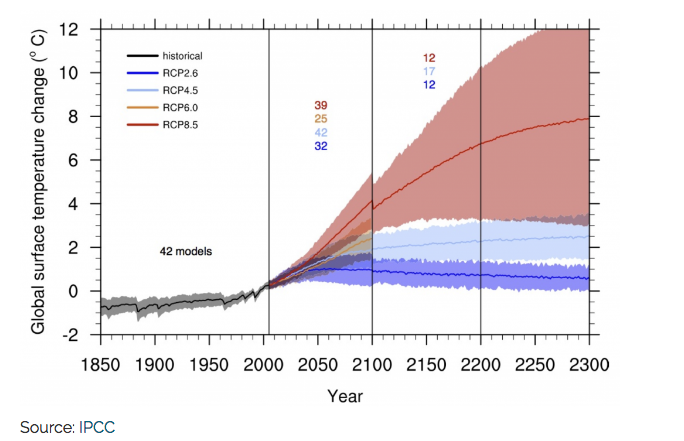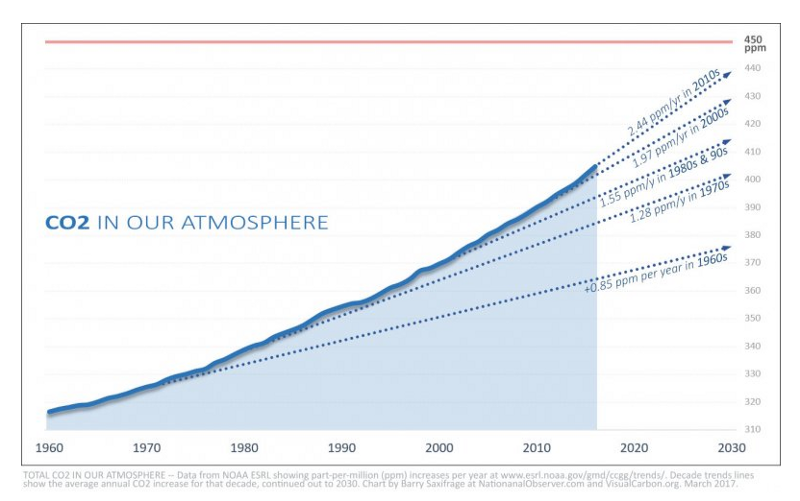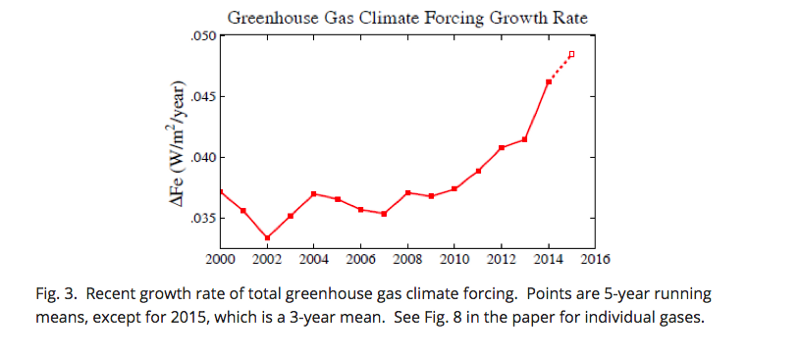A Defense of Climate Tragedy, or What the Scientists Got Wrong about “The Uninhabitable Earth”
ENVIRONMENT, 31 Jul 2017
Genevieve Guenther | Medium – TRANSCEND Media Service
14 Jul 2017 – This is an essay about the furor over David Wallace-Wells’ New York Magazine article “The Uninhabitable Earth,” which conjures a specter of a planet so ruined by global warming in our children’s lifetimes that it no longer sustains, but destroys human life.
By his own account, Wallace-Wells (DWW from here on out) wrote “The Uninhabitable Earth” to frighten people out of their complacency and to inspire them to clamor loudly for immediate action to halt climate change in its petrifying tracks. Yet instead of welcoming DWW as an ally, some climate scientists attacked him, roundly criticizing his article for supposedly inspiring paralyzing sense of doom in its readers and, more importantly, for lacking scientific credibility. In a lengthy post on Climate Feedback — a site that publishes scientific assessments of representations of climate change in the popular press — these scientists condemned DWW for making factual errors, for exaggerating the projected impacts of unmitigated climate change, and for downplaying the low probability of those impacts occurring even under the high-emissions “business as usual” path that we are currently on. It is this Climate Feedback post, entitled “Scientists explain what New York Magazine article [sic] on ‘The Uninhabitable Earth’ gets wrong,” that I want to discuss.
My goal is not to quibble with the scientific critiques in the piece, for I have no expertise in that regard. I am not a scientist, but a climate activist currently writing a book about the political ramifications of the words we use to represent climate change. I’m also a literary critic whose first book was a cultural history of the idea that art has transformative power. So I know something about how literary texts produce responses in their readers and how those responses have cultural effects. What I can do here is examine how the scientists criticize DWW for using literary language to represent the extreme, “fat-tail” effects of unmitigated climate change in ways that produce terrifying mental images of climate devastation.
Why bother to do this? Well, for one thing, an examination of the scientists’ criticisms demonstrates that the representation of climate change in “The Uninhabitable Earth” isn’t quite as inaccurate as the scientists want us to believe. (“Many … explanations in the article are correct, but readers are likely left with an overall conclusion that is exaggerated compared to our best scientific understanding,” one scientist says. This sort of claim about what a reader might conclude is a kind of armchair literary critique, not a scientific assessment. Here the scientific assessment is that “many … explanations in the article are correct.”) For another and more important thing, the Climate Feedback piece, like the whole controversy itself, raises important questions that need to be thought through as we attempt to halt climate change in our post-truth culture.
If scientists, and by extension “science communicators,” must make every effort to articulate scientific truth — that is, to make precise, highly qualified claims that describe the world with the highest possible degree of certainty — must everyone who represents climate change speak this way? Must writers forego the tools and techniques of thousands of years of literary culture when they narrate what science itself says may happen to us if we do not stop burning fossil fuels right now? Moving forward, will scientists allow writers — and, by extension, filmmakers, dramatists, painters, historians, “theorists,” composers, etc — to represent climate change in ways that are designed to incite terror and hope and anger and love and all the passions that give people the momentum to fight political fights? Is it possible for the language of climate change to transcend the genre of “science communication” and become animated by art?
****************************
Before I continue, let me say that I think there’s some merit to the critique that DWW is a bit “doomist” in his article. What makes him so is not that he narrates the most harrowing effects of climate change as if they would happen all at once or that he posits a relationship between climate change and extinction. Rather it’s that he silently but strongly implies in his conclusion that even the most alarmed scientists are optimistic that we can avoid climate apocalypse only because they lack the imagination to see what “The Uninhabitable Earth” has laid so shockingly before our eyes. “Climate systems,” DWW writes, “designed to give feedback over centuries or millennia prevent us — even those who may be watching closely — from fully imagining the damage done already to the planet. But when we do truly see the world we’ve made, [the scientists] say, we will also find a way to make it livable. For them, the alternative is simply unimaginable.” For them the alternative is unimaginable, but not for DWW — who has imagined our destruction so fully and eloquently in his article — and not, now, for us.
In other words, in “The Uninhabitable Earth” DWW casts himself as a kind of prophetic Tiresias to humanity’s blind Oedipus, warning us about what we’re tragically fated to suffer because we’ve recognized ourselves too late (“Two degrees of warming used to be considered the threshold of catastrophe: tens of millions of climate refugees unleashed upon an unprepared world. Now two degrees is our goal, per the Paris climate accords, and experts give us only slim odds of hitting it.”) Further, he implicitly blames the scientists for our ongoing blindness, suggesting we have not yet mobilized successfully against climate change because our concept of global warming has been constrained by the anemic and ineffective “scientific reticence” that produces “the timid language of scientific probabilities.” I can only imagine how provoking all this must be to climate scientists who, let’s be frank, are heroically dedicating their lives not only to poorly-remunerated research and teaching, but also to fending off the coordinated and unrelenting attacks of climate deniers in government and the media, all while receiving repeated death threats for their efforts. No wonder they went after him! As a friend of mine who works on climate campaigns in the Bay Area wrote me after reading the article: “To think that even the scientists who are talking about climate change are perhaps not accurately portraying just how dire the situation is … that’s very terrifying.”
But about that terror. To me there’s something a bit metaphysical about it — about the idea that we cannot prevent ourselves from causing our own extinction, as if we, humanity as a species, had an indelible flaw that inexorably led us to destroy ourselves, or as if our nature were to enact a tragedy that won’t even leave anyone behind to enjoy catharsis. (“We have not developed much of a religion of meaning around climate change that might comfort us, or give us purpose, in the face of possible annihilation,” DWW writes.) I actually think that such metaphysical thoughts arise inevitably once you start brooding on climate change. I myself have them often. But there’s a political critique of the universalizing, essentializing premise underlying such thoughts. It goes like this: is all of humanity really driving our destruction? Or do the majority of people in the world, and even in America, want to decarbonize the global economy, but are being blocked right and left by the fossil-fuel industry and their minions in governments?
*****************************
As we know, the scientists did not mount that particular critique. Instead, circling their disciplinary wagons, as it were, they attempted both to assure their readers that they have not, in fact, anemically underreported the risks of unmitigated climate change and to insist the reason “The Uninhabitable Earth” was so terrifying was that it took literary license representing the facts. Just a few examples. “The author takes significant literary license to leverage information grounded in truth and paint an apocalyptic picture of extreme future scenarios possibly driven by anthropogenic climate change,” one scientist complains. To which I respond: yes, exactly! Another scientist complains that the article traffics in bad dreams or genre fiction, dismissing the “nightmare scenarios” depicted in the article as “ridiculous” and “clumsily wrapped together,” and insisting “there’s no reason yet to think much of the world will become uninhabitable or look like a science fiction novel.” Yet this same scientist notes that if we don’t stop emitting CO2 now, “food security” will be “an issue at stake” and “patches of uninhabitable areas (for humans) could start to open up in the tropics.” He also acknowledges that if we continue business as usual the world will warm 4–5°C in eighty-three years (one long lifetime) — calling this “a big cause for alarm” — and he even points out that the convention of ending climate projections at 2100 obscures the fact that our planet will continue to warm after that date. A cursory glance at an IPCC graph which appears elsewhere in the Climate Feedback post (and which I reproduce later in this essay) shows that on RCP 8.5, our current emissions pathway, we can expect Earth to warm about 8°C by 2150 and 10°C by 2200. 2150 is, of course, only 133 years away. 133 years is nothing. A blink! Less than half the time between us and Shakespeare. About the time between my grandmother’s birth and my current age. Is it really so ridiculous to narrate what terrifying things could possibly happen if the earth warmed 8°C in 130 years?
This kind of eye-rolling, defensive refusal to countenance that climate change might actually be scary leads another scientist to accuse DWW of misrepresentation while he, with some irony, misrepresents what DWW actually says. “The concept of the Earth becoming uninhabitable within anywhere near the timescales suggested in the article is pure hyperbole,” this scientist confidently assures us. But Wallace-Wells never says “the earth” will become uninhabitable. What he does say: “absent a significant adjustment to how billions of humans conduct their lives, parts of the Earth will likely become close to uninhabitable, and other parts horrifically inhospitable, as soon as the end of this century” (emphasis added). Is this really such a hyperbolic claim? One of the climate scientists DWW interviewed for his piece said in his interview (whose transcript New York Magazine published): “A good fraction of the tropics are now too warm essentially for human habitation, and there are studies that show that once you warm temperatures by even a few degrees by what they are currently in the tropics, basically you can’t work outside. Productivity plummets, agriculture plummets, basically these regions become unlivable.” Admittedly, the title of the piece, “The Uninhabitable Earth,” implies a planet fully inimical to human life, but science communicators know well that authors are not always responsible for the titles of their articles.
***********************************
Speaking of titles, let’s now turn to the title of the Climate Feedback article. “Scientists explain what New York Magazine article [sic] on “The Uninhabitable Earth” gets wrong.” This title itself is a misrepresentation. In reality, the Climate Feedback article doesn’t only explain what DWW gets wrong; it also explains what DWW gets right. So, as part of my defense of climate tragedy, I’d like to list all the places where the Climate Feedback article highlights the accuracy of what DWW represents. (Quoted text is from the article; sentences in italics are DWW’s.) The list is surprisingly long.
- “This is well-researched and on target, unfortunately.”
- “Most statements in the article are based on peer-reviewed literature.”
- “It is qualitatively true — and often under-appreciated — that the likelihood of a ‘worse than expected’ climate future is actually higher than a ‘better than expected’ one.”
- Although the earth will not become uninhabitable by 2100, even in a worst-case scenario of business-as-usual emissions, “it is clear that ongoing warming to the global climate would eventually have very severe consequences” and DWW does accurately address “a number of climate threats that are indeed major issues.”
- Although it focuses on worst-case scenarios, which are statistically unlikely, “this is an unusual piece in that it accurately describes some of the most dire consequences of unabated global warming.”
- “The global temperature could indeed reach 4–5 degrees by 2100, if humans don’t do anything to our emissions, and beyond this patches of uninhabitable areas (for humans) could start to open up in the tropics, due to heat stress limits imposed by the evaporative limits of our body”
- “Indeed, a world 5+ degrees warmer is a big cause for alarm.”
- Even changing the climate just enough to make, for example, New York in 2100 like Georgia today “is still an important basis for concern given that the socio-political infrastructure that exists around the world is biased toward the modern climate.”
- “Food security is indeed an issue at stake.”
- “We are taking the climate system out of known territories. There will be many surprises and they are what worry me the most. Uncertainty is not our friend and that makes it very hard to say which worst-case scenarios are unrealistic.”
- Although DWW’s title is hyperbolic, to point that out is “not to downplay the very real and very large threat to human lives, economies, infrastructure, ecosystems, and species — and the author does a good job cataloging many of these later in the piece.”
- At least four feet of sea-level rise and possibly ten by the end of the century. “This statement is supported by peer-reviewed literature.”
- At four degrees, the deadly European heat wave of 2003, which killed as many as 2,000 people a day, will be a normal summer. At six, according to an assessment focused only on effects within the U.S. from the National Oceanic and Atmospheric Administration, summer labor of any kind would become impossible in the lower Mississippi Valley, and everybody in the country east of the Rockies would be under more heat stress than anyone, anywhere, in the world today. “In general, the language in this paragraph is dire, but, in my opinion, this is an under-appreciated consequence of global warming, and the author does well to highlight it.”
- “There is indeed evidence that the frequency and intensity of floods/droughts is increasing over much of the globe, and will continue to do so as the climate warms.”
- “In general, it’s true that there will be dramatically more flood and drought events on a global basis with multiple degrees of warming.”
- The strongest hurricanes will come more often. “This is a plausible claim, especially in a ‘six degree warmer world’.”
- Hail rocks will quadruple in size. “There is indeed evidence that maximum hail size in severe thunderstorms may increase with global warming (even while overall hail frequency will decrease).
- “The ‘notorious’ extinction 242 million years ago, at the end of the Permian, clearly (based on oxygen isotope proxy data) was accompanied by significant global warming likely triggered by the eruption of the “Siberian Traps” volcanoes, with concomitant buildup of carbon dioxide.”
- “During the last interglacial … Earth was [approximately] 2° C warmer than temperatures in the 19th century, and sea levels were about 5–6 meters higher. This suggests that even a “good-case, 2° C” long-term warming in our future could also raise oceans by that much eventually, even if the pace of that rise (and thus the amount of rise by 2100) is uncertain.”
- “While historically, IPCC-type projections stop in 2100 by convention, warming does not stop then, in particular for very high (perhaps implausibly high) greenhouse gas emission scenarios: warming goes on in the following centuries, up to ten of degrees in the worst case.”
[I’d like to pause here to consider this scientist’s parenthetical claim that very high emissions scenarios are “perhaps implausibly high”: Barry Saxifrage, an energy analyst and reporter for The National Observer, compiled data from the latest “BP Statistical Review of World Energy,” one of the most referenced annual reports on energy consumption. Saxifrage found that in 2015 humanity set a fossil-fuel energy record of 11.4 billion tons of oil equivalent (Gtoe). (For context: “A decade ago we were at 10 Gtoe of energy. In 2000, we were at 8 Gtoe.”) As Saxifrage points out, “there is no sign of a turning point in our atmosphere, but CO2 levels are actually accelerating upwards.” (http://bit.ly/2vbLUAz)
And just last week, James Hansen published a paper in Earth System Dynamics which demonstrates that “the growth rate of greenhouse gas climate forcing has accelerated markedly in the past several years (Fig. 3), a conclusion starkly at odds with the common narrative that the world has recently turned the corner toward a solution of the global warming problem.” The following is “Fig. 3”:]
- Climates differ and plants vary, but the basic rule for staple cereal crops grown at optimal temperature is that for every degree of warming, yields decline by 10 percent. Some estimates run as high as 15 or even 17 percent. Which means that if the planet is five degrees warmer at the end of the century, we may have as many as 50 percent more people to feed and 50 percent less grain to give them. “These numbers stem from the results of controlled field sites (in, for example, the Philippines, India and Mexico) and refer to the impact of local temperature changes on yield, all else being equal. (Also, note that the major grain producing regions are in the midlatitudes, where the projected temperature increases are substantially greater than the projected global average temperature increase.)”
- The tropics are already too hot to efficiently grow grain, and those places where grain is produced today are already at optimal growing temperature — which means even a small warming will push them down the slope of declining productivity. “This statement is mostly accurate. To be more precise, it would read ‘Temperature in the tropics is already greater than the optimal temperature for growing the major crops (rice, wheat, maize)’” [emphasis mine].
- “Obviously, temperature-driven droughts will still have large and adverse consequences for agriculture in many regions — so the broader point made here regarding large risks to food production is reasonable.”
- “Even with no change in the natural variability in growing season temperature, increasing summer averaged temperature will likely lead to increased volatility in grain production in the midlatitudes because of the nonlinear relationship between temperature and yield.”
- “There is, indeed, some research showing impairments in cognitive function test scores in people exposed to CO2 concentrations in the 950–1,000 ppm range, and even significantly worse performance when CO2 gets to 1,500 and 2,500 ppm.”
*********************************
During the uproar over “The Uninhabitable Earth” more than one scientist insisted that the truth about climate change is scary enough — there’s no reason to exaggerate it. But I wonder how whatever anxiety the list above might have provoked in you, reader, compares to what you felt when you read “The Uninhabitable Earth”? In the sixteenth-century The Defense of Poetry, the first piece of literary theory written in English, Sir Philip Sidney argues that the poet is actually a better teacher — a better leader into virtue — than the philosopher (by which he means also the scientist) because the poet “yieldeth to the powers of the mind an image of that whereof the philosopher bestoweth but a wordish description, which doth neither strike, pierce, nor possess the sight of the soul so much as that other doth.” If the essentialism of climate despair hides the mutable social and economic conditions that allow the selfish few destroy the many, the answer to despair is to rise up and fight. So we must let the writers strike, pierce, and possess the sight of our souls with what may lie before us and our children if we do not rise up and fight. It is not the role of the scientists to do this. If they have not been doing this, it’s not because they have failed, but because they have been doing their jobs, producing and communicating the 95–100% certain knowledge that enables activists and policy-makers to say confidently that the science is settled and we must act yesterday. It is the role of the writers — and the filmmakers, and the dramatists, and the visual artists, and so on — to move people to create the groundswell of fear and desire that forces the necessity of action. The scientists must let the writers do their jobs. On their work, on all our work, the world depends.
__________________________________
 Genevieve Guenther – Author and climate activist with a PhD in Renaissance Literature. A member of Al Gore’s Climate Reality Leadership Corps, she teaches at the New School.
Genevieve Guenther – Author and climate activist with a PhD in Renaissance Literature. A member of Al Gore’s Climate Reality Leadership Corps, she teaches at the New School.
DISCLAIMER: The statements, views and opinions expressed in pieces republished here are solely those of the authors and do not necessarily represent those of TMS. In accordance with title 17 U.S.C. section 107, this material is distributed without profit to those who have expressed a prior interest in receiving the included information for research and educational purposes. TMS has no affiliation whatsoever with the originator of this article nor is TMS endorsed or sponsored by the originator. “GO TO ORIGINAL” links are provided as a convenience to our readers and allow for verification of authenticity. However, as originating pages are often updated by their originating host sites, the versions posted may not match the versions our readers view when clicking the “GO TO ORIGINAL” links. This site contains copyrighted material the use of which has not always been specifically authorized by the copyright owner. We are making such material available in our efforts to advance understanding of environmental, political, human rights, economic, democracy, scientific, and social justice issues, etc. We believe this constitutes a ‘fair use’ of any such copyrighted material as provided for in section 107 of the US Copyright Law. In accordance with Title 17 U.S.C. Section 107, the material on this site is distributed without profit to those who have expressed a prior interest in receiving the included information for research and educational purposes. For more information go to: http://www.law.cornell.edu/uscode/17/107.shtml. If you wish to use copyrighted material from this site for purposes of your own that go beyond ‘fair use’, you must obtain permission from the copyright owner.



